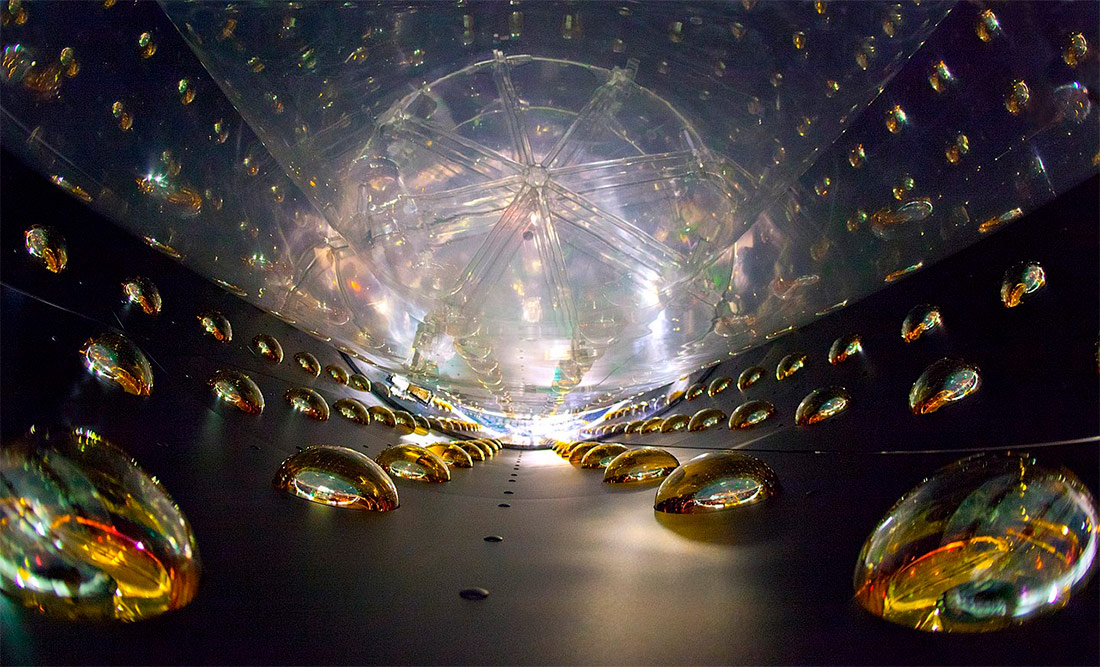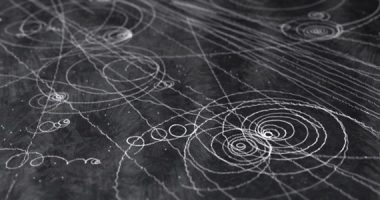
Abbot Academy student using telescope, 1940-1949 | The Trustees of Phillips Academy, Digital Commonwealth | CC BY-SA
New advances in science are bringing us ever-greater degrees of control. Will the neuron, the atom, DNA, and the bit take the permanent throne as our fundamental building blocks of design? Or can we go one step further? Astronomers have deduced that the matter we see and perceive is only a fraction of what exists. Dark matter, something we know little about, is said to comprise 83 percent of all matter in the universe, and – one day soon – might enter the conversation, as the next material with which we can expand our realm of control.
“Dear Radioactive Friends, today I have done a terrible thing for a theoretical physicist, that is, to introduce a new particle that nobody will ever be able to see.”
Wolfgang Pauli, 1930s
It’s been said that we are a geological force. Over the short history of humankind we have learned to transform materials from the biosphere to our convenience. Technicians have been trained in the art of transforming rocks into square-shaped hills for us to inhabit. Communication technologies have also contributed to the formation of new landscapes on our planet’s surface. Recent efforts in science have attempted to develop design methods and tools towards an integrated biologically-engineered environment, and synthetic biology is emerging as a promising field towards a soft and evolutive process of integration with nature. We are now able to engineer matter itself. But according to astrophysics such matter and all visible matter in our immense universe scarcely represent four percent of what’s out there. The remaining is dark to us. Indeed it’s called dark matter.
Can designers explore ways of understanding and interacting with dark matter? To what degree is it possible to modify visible matter and even address challenges unreachable within our current production model? Although seemingly audacious, to address dark matter is a substantive hypothesis, and speculating on its potential for design could help unlock the confines of design and its subsequent realities. After all, no one took Fritz Zwicky very seriously when he first suggested the existence of dark matter back in the 1930s.
The idea of engineers dabbling with biology and designers exploring future materials is not speculation, but real current practice. The frontiers of design have been made possible by the confluence of technical advances and increasing collaboration between different knowledge fields. Today, bio-engineered design products are tested in laboratories, as designers become accustomed to interact and exchange ideas with biologists, material scientists, biological engineers, and bio-programmers.
We’ve arrived at the stage where we can manipulate the very stuff life is made of: the cell. Formed by molecules of atoms joined by energy, further broken down into configurations of protons, neutrons, and electrons, living things are made up of the same chemical components as non-living things; and they all obey the same physical and chemical laws at the macroscopic level. Astronomers refer to this as “baryonic matter”. In looking to dark matter, we step into the little-known world of “non baryonic-matter”.

A Hubble Space Telescope image of the galaxy cluster MACS0416 (left), and the same image (right) overlaid with the distribution of dark matter, shown in blue. Explorations by Priyamvada Natarajan and her team studying the distortion of light from distant background galaxies | ESA/Hubble | Public Domain
Dark Matter as the Rule in the Cosmos
“We do live in a very peculiar universe. The inventory of our universe is most bizarre. Most of what we know is a tiny fraction of the universe, 4 to 5 percent is the matter that we know, the atoms that we know, the elements that are in the periodic table. The vast majority of stuff in the universe—both dark matter and dark energy, which dominate the universe—, its fate and its contents are unknown. I’m being somewhat modest when I say that we’re looking for a gap. We’re actually waiting for some kind of revolution. But one never quite knows when revolutions start.”
Priyamvada Natarajan, The Exquisite Role of Dark Matter
The cosmos is mostly formed by dark energy and dark matter. Although virtually imperceptible, it is believed that dark matter constitutes approximately 83 percent of all matter in the universe. Dark matter pulls things together, generates attractive gravity, and even suggests new particle species. To understand the largest structures in the cosmos we should understand the structure of its smallest particles, going from outer space to inner space, as if taking the journey suggested by the Eames’ film Powers of 10. Although most matter in the universe is dark, we only perceive its gravitational effects. Matter as we know it is just a thin network of threads connecting clusters of dark matter. Within these nodes dark matter accumulates and galaxies are formed.
Nobody knows exactly what dark matter is made of. The Cold Dark Matter hypothesis posits that they are “weakly interacting massive particles” (WIMPs) because they can pass through ordinary matter without any effects, yet they have mass. A few hypothetical WIMPs have been suggested including neutrinos, axions, and neutralinos. A neutrino is an electrically neutral elementary particle that is able to pass through ordinary matter almost undisturbed. Neutrinos have a minuscule, but nonzero mass. Axions are particles with minimum mass that would have been produced abundantly in the Big Bang. They have been proposed to explain why the neutron is electrically neutral. Neutralinos are massive particles – they may be 30 to 5000 times the mass of a proton.
Scientists are already exploring the occurrence of these particles, deep underground and way out in space. A good example is the CERN particle physics laboratory, situated in the northwest suburbs of Geneva on the Franco-Swiss border, with the Large Hadron Collider tunnel located one hundred meters underground in the region between the Geneva airport and the nearby Jura mountains. There is also the Lake Baikal Neutrino Telescope for deep underwater neutrino research. The IceCube Neutrino Observatory is the largest neutrino telescope in the world and, there, a team of pioneering researchers have buried thousands of sensors miles deep into the ice at the bottom of the earth, all in an attempt to catch the rare neutrino, from atmospheric and astrophysical sources, crashing into atoms of ice.
Recent theoretical and experimental proposals reveal interesting paths: one physicist in the US has calculated that dark matter could arise in a simple generalized quantum theory of gravity. Other theories, like Maxim Pospelov’s, posit bubble-like structures called “domain walls”, which could be detected with a network of magnetometers situated strategically around the world. Professor Priyamvada Natarajan explores and maps how dark matter is spatially distributed in the universe by means of gravitational lensing (the bending of light by dark matter), noting that there are regions with higher accumulation of dark matter. Kathryn Zurek and Dan McKinsey at Berkeley Lab and UC Berkeley are developing new experiments using liquid helium and gallium arsenide crystals to detect low-mass dark matter traces in previously unexplored ranges of particle mass and energy. If new methods of observation, simulations or speculations about dark matter were to be found, inviting input from different disciplines, including art and design among them would bring unexpected ideas about what and where to search.

The Daya Bay antineutrino detector | Roy Kaltschmidt, Lawrence Berkeley National Laboratory | Domini públic
Designing with Dark Matter
Is it possible to design with dark matter? Is it possible to interact with and even manipulate things we are not able to see? If we are reaching the limits of the sensitivity with our experiments, then designing broader perception tools might be the first place to start. Artist Neil Harbisson has already pointed to new ways of enlarging perception, by wearing a device that allows him to hear colors. Following Maxim Pospelov’s suggestion, we could start by searching for devices that expand our range of perception of the matter spectrum. In Planetary Echoes, Lukas Feireiss and Michael Najjar notes that imagining humans as a multi planetary species in not a mere fantasy anymore, and compile a series of attempts of connecting artistic research and abstract theoretic sciences. In the same way, we can speculate on what would it be like the human perception of dark matter.
It might be needed an open research platform linking all the efforts carried out individually by different disciplines. Transdisciplinary workshops and spaces could be established taking advantage of new forms of fabrication already practiced by community biology labs like GenSpace or bioCurious. CERN already hosts the Arts at CERN programme to foster the dialogue between artists and physicists. This new collective creativity could imagine new devices in order to experiment with matter at a quantum level, from quantum biolasers to models of new interstellar stations constructed with non-carbon materials and quantum displacement by means of teletransportation. These labs could explore ways of inhabit at distant planets as evolving forms of human cyborgs adapted to such conditions.
Quantum mechanics theory poses that the crossroads between physics and consciousness at atomic levels can be applied to all; even to the entire universe. It’s possible that new unimagined devices collectively created, could lead us to perceive and manipulate neutrinos and other subatomic particles, and from there start programming atoms, just as today we are able to program cells. We would be able to move through wormholes excavated in dark matter traveling at entangled states accompanied by Schrödinger’s cat.
An earlier version of this post originally appeared at: César Reyes Nájera and Ethel Baraona Pohl. «On the Surface of a Dust Particle». Volume 35 Everything Under Control. Archis Foundation, Amsterdam, 2013.




Leave a comment